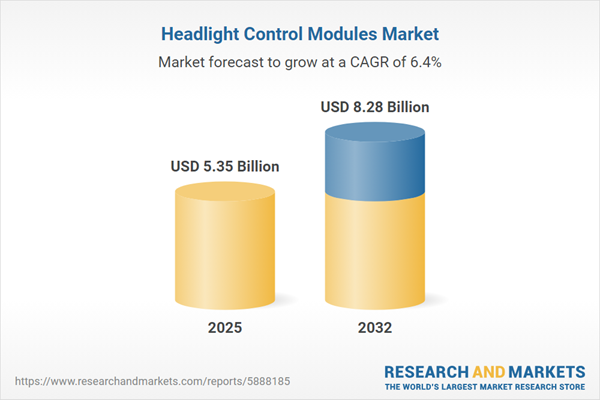Speak directly to the analyst to clarify any post sales queries you may have.
The headlight control modules market is evolving rapidly amid rising demand for advanced vehicle lighting and tighter regulatory oversight. Senior decision-makers face pivotal choices in adapting to major technological, regulatory, and supply chain disruptions shaping the industry's future.
Market Snapshot: Headlight Control Modules Market Growth
The headlight control modules market grew from USD 5.02 billion in 2024 to USD 5.35 billion in 2025. It is poised to continue its upward trajectory at a CAGR of 6.43%, reaching USD 8.28 billion by 2032. Market expansion is linked to heightened safety standards, robust OEM integration of adaptive lighting systems, and regional adoption trends shifting towards digital, connected solutions.
Scope & Segmentation
This research delivers a comprehensive analysis across key dimensions and provides actionable segmentation for informed strategy development.
- Lighting Types: Adaptive lighting modules; Conventional systems focused on reliability and cost.
- Vehicle Types: Modules tailored for commercial vehicles demanding robust, durable components; Passenger cars prioritizing size, design, and integration with premium features.
- Applications: OEM solutions with custom firmware and strict validation; Aftermarket modules requiring universal compatibility and easy installation.
- Technologies: Halogen; HID; LED; Xenon modules, supporting both entry-level and premium vehicle segments.
- Regions Covered:
- Americas: United States, Canada, Mexico, Brazil, Argentina, Chile, Colombia, Peru
- Europe, Middle East, and Africa: United Kingdom, Germany, France, Russia, Italy, Spain, Netherlands, Sweden, Poland, Switzerland, United Arab Emirates, Saudi Arabia, Qatar, Turkey, Israel, South Africa, Nigeria, Egypt, Kenya
- Asia-Pacific: China, India, Japan, Australia, South Korea, Indonesia, Thailand, Malaysia, Singapore, Taiwan
- Company Profiles: Industry coverage includes HELLA GmbH & Co. KGaA, Valeo SA, Koito Manufacturing Co., Ltd., Stanley Electric Co., Ltd., ZKW Group GmbH, Marelli Holdings Co., Ltd., Denso Corporation, OSRAM Licht AG, Continental AG, and Panasonic Corporation.
Key Takeaways: Strategic Insights for Senior Leaders
- Adaptive and matrix LED modules are reshaping advanced lighting, pushing suppliers to innovate across software and hardware, enabling highly customizable and efficient illumination.
- Integration with broader vehicle electronics, such as driver assistance and infotainment, accelerates scenario-based lighting strategies that enhance safety and user experience.
- Transition toward modular hardware platforms and scalable software supports over-the-air updates, expediting lifecycle extension and post-sale monetization via firmware enhancements.
- Rising energy efficiency demands and weight reduction objectives are spurring lightweight, high-efficiency power drivers and the evolution of module enclosures.
- OEM validation and aftermarket customization present distinctly different challenges; adaptability and targeted R&D are vital for serving both segments.
- Geographically, adoption patterns are shaped by regulatory priorities, supply chain realignments, and consumer preference for premium or energy-saving solutions.
Tariff Impact: Navigating 2025 Supply Chain Disruptions
Planned tariff adjustments for 2025 are driving manufacturers to reconfigure sourcing and procurement strategies. Anticipated higher duties on imported components prompt supplier diversification, near-shoring efforts, and value engineering in module design. Firms are strengthening ties with upstream partners, evaluating local assembly, and revisiting material choices to alleviate cost pressures and maintain operational agility amid changing trade landscapes.
Methodology & Data Sources
This report leverages a hybrid approach combining primary interviews with R&D engineers, product managers, and procurement specialists, alongside exhaustive reviews of regulatory documents, patent filings, and supplier releases. Quantitative and scenario-based analysis underpins forecasts, while qualitative validation ensures practically relevant insights.
Why This Report Matters
- Enables informed decision-making by providing a structured view on market drivers, technology advances, and regional nuances within the headlight control modules segment.
- Assists in developing adaptive strategies that address both competitive innovation and emerging regulatory or supply chain risks.
- Provides clear segmentation and actionable intelligence for tailoring offerings to specific vehicle types, technologies, and regions.
Conclusion
The headlight control modules market presents dynamic opportunities and supply chain complexities for senior stakeholders. Aligning product strategies with advancing technologies and evolving regional requirements is essential for sustainable growth and resilience.
Additional Product Information:
- Purchase of this report includes 1 year online access with quarterly updates.
- This report can be updated on request. Please contact our Customer Experience team using the Ask a Question widget on our website.
Table of Contents
3. Executive Summary
4. Market Overview
7. Cumulative Impact of Artificial Intelligence 2025
Companies Mentioned
The companies profiled in this Headlight Control Modules market report include:- HELLA GmbH & Co. KGaA
- Valeo SA
- Koito Manufacturing Co., Ltd.
- Stanley Electric Co., Ltd.
- ZKW Group GmbH
- Marelli Holdings Co., Ltd.
- Denso Corporation
- OSRAM Licht AG
- Continental AG
- Panasonic Corporation
Table Information
| Report Attribute | Details |
|---|---|
| No. of Pages | 197 |
| Published | October 2025 |
| Forecast Period | 2025 - 2032 |
| Estimated Market Value ( USD | $ 5.35 Billion |
| Forecasted Market Value ( USD | $ 8.28 Billion |
| Compound Annual Growth Rate | 6.4% |
| Regions Covered | Global |
| No. of Companies Mentioned | 11 |









